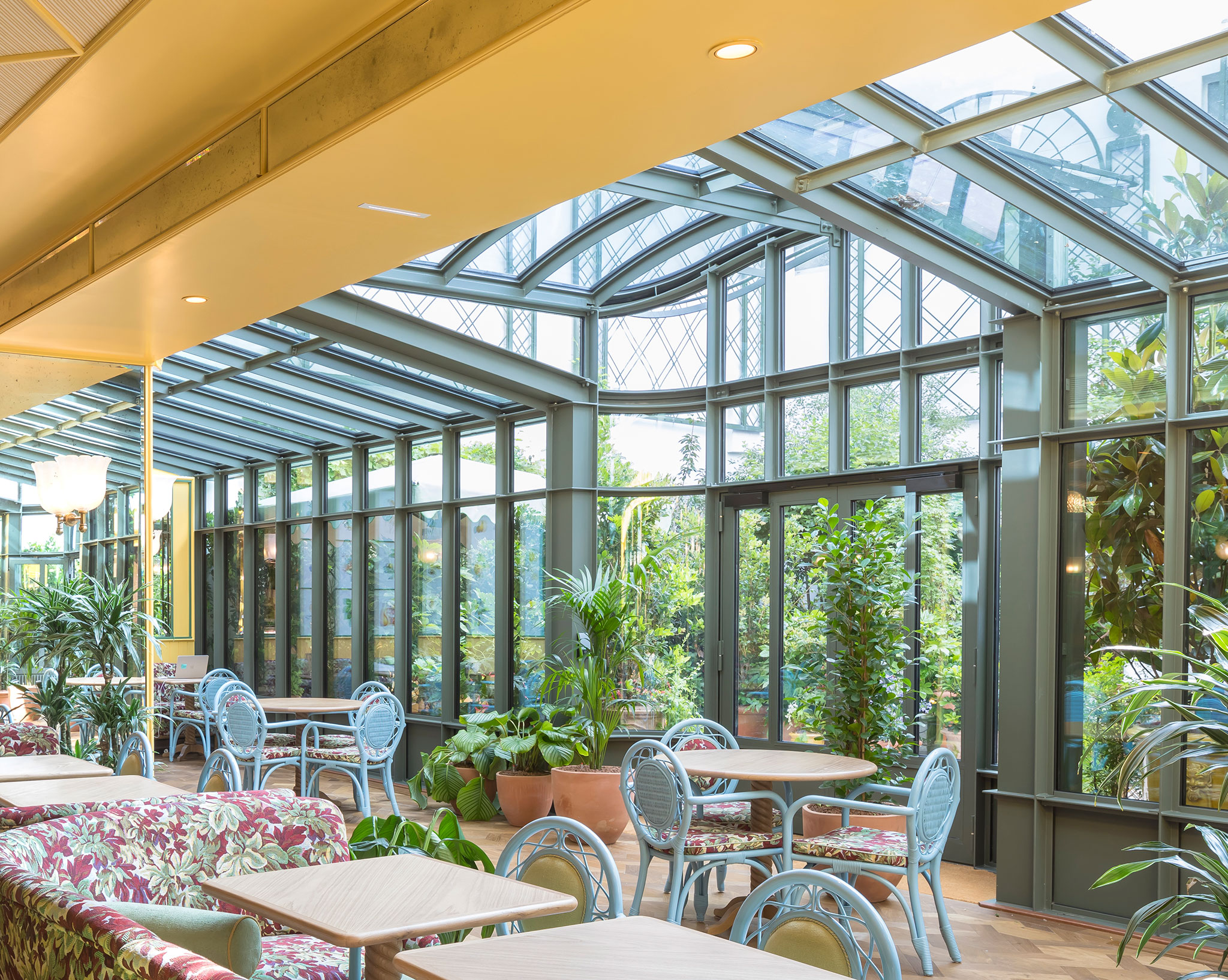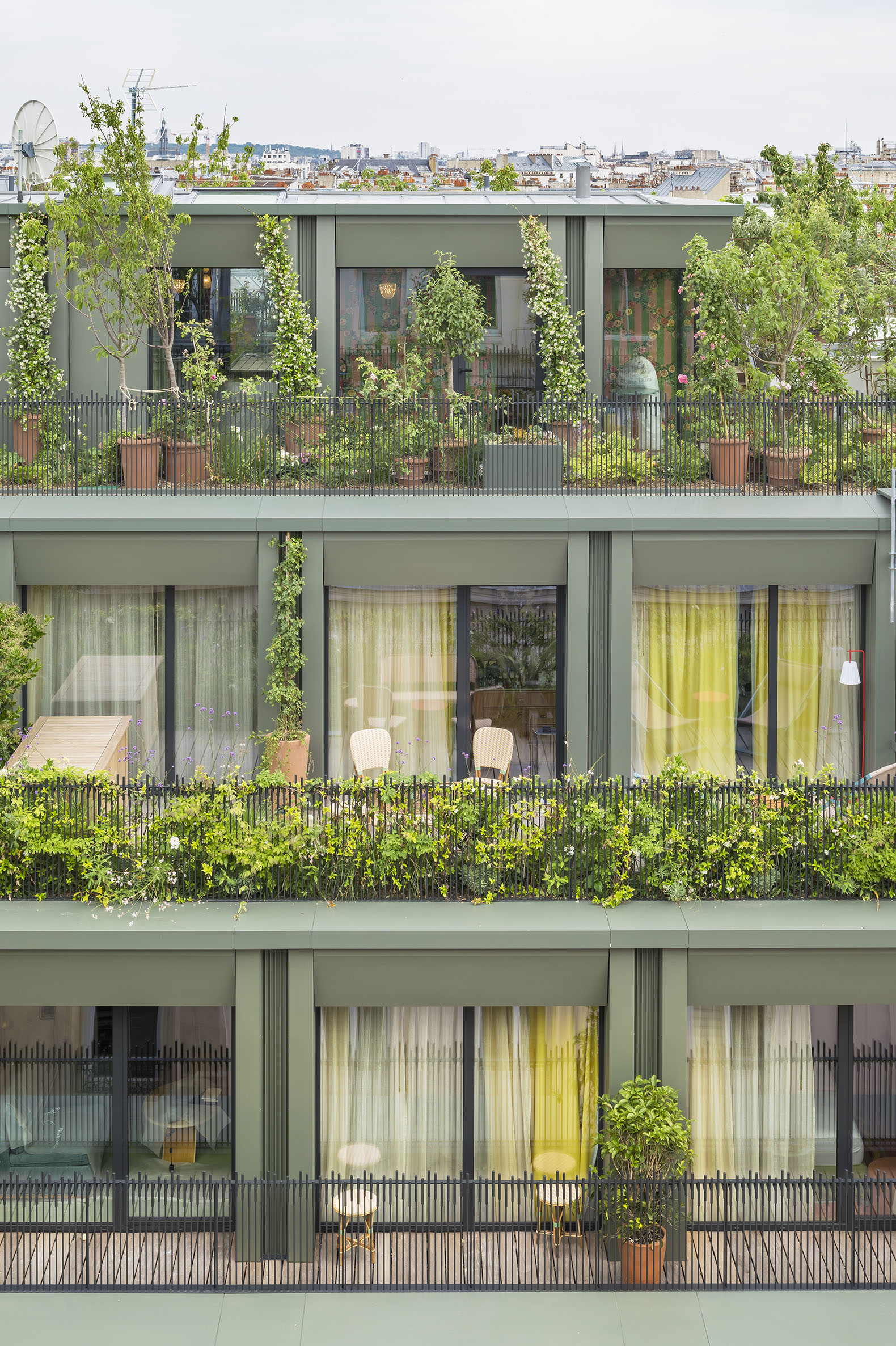The rooms were expanded and modified to provide direct communication with the street or the garden, while the urban contours of the building have been completed and simplified for a more harmonious and coherent integration with the context within the local fabric.
The materiality of the façade, composed of zinc with an aged gray-green finish, refers to the Parisian landscape with its zinc and copper roofs, while the ceiling-high windows with steel frames refer to the greenhouses that were there.

La Fantaisie Hotel by PetitdidierPrioux Architectes. Photograph by Sergio Grazia.
Project description by PetitdidierPrioux Architectes
A Garden Hotel with an Urban Mindset
In a city with such a broadly diversified hotel market, the search for a new hospitality concept necessarily implies finding ways to stand out. But how do you avoid the pitfall of formal overstatement — an abundance of distinctive signals often resorted to as a recipe for commercial success?
Firmly rooted in its city and its history, newly opened La Fantaisie Hotel develops a modernised relationship to the street beyond its generous and refined façade. Rather than leaning towards grand gestures, the building aims to impress through an intimate conversation with its surroundings and the urban experience it delivers.
The hotel is set in the 9th arrondissement, a popular tourist district in central Paris, which is not only one of the densest areas in the city, but also one with the smallest proportion of green spaces. And yet, when Rue Cadet was built in the 17th century, it was originally intended as an access road serving vegetable plots; and the Cadet family, after whom the street was named, had been master gardeners since Charles IX.
The project’s site was already occupied by a hotel built in the late 20th century. Its architecture — a vague pastiche of a classical townhouse — looked somewhat dated and broke conspicuously with the overall scale and style of this narrower section of the street. The building’s understated and cramped accesses left no space to create an active street frontage on the ground floor, while the garden at the back felt like an afterthought.

La Fantaisie Hotel by PetitdidierPrioux Architectes. Photograph by Sergio Grazia.
Composing with the Existing
The project was to deliver a comprehensive overhaul of the existing, wiping out all signs of outdated architecture while conserving much of the otherwise sound structure. Reinventing and transforming the building as it stood provided the opportunity for greater acceptance of the project from local residents — as no heavy demolition work was involved — and a less resource-intensive design.
This frame of mind guaranteed the best possible environmental approach during construction: additions were developed precisely, with a light touch, and each intervention was thoughtfully considered to solve problems without generating any useless inflation.
A Lively Haven
The new hotel has been designed as a haven, halfway between the hustle and bustle of the city and the peaceful quietude of an urban getaway. To do so, one of the challenges was to incorporate breathing spaces into the layout, thus curating an experience where guests are taken along a reinvigorating journey and creating interest outside the rooms — with an expanded and newly landscaped garden; a largely open-plan ground floor layout with an urban garden feel and featuring new services (retail accommodation); wellness facilities supplanting the unutilised underground parking garage; public access to the rooftop affording panoramic views of the roofs of Paris.
The rooms have been expanded and their geometry altered to provide direct communication with either the street or the garden. The building’s urban contours have been filled in and streamlined for more harmonious and context-coherent integration within the local fabric. The streetside façade has been designed as a full-height filter, sheer and elegant, resulting in a new urban landmark. Its expression reveals the simple and geometric layout of the rooms, incorporating floor-to-ceiling windows to make up for the lack of natural light in a relatively narrow street. To protect guests from unwanted eyes, small balconies have been added, providing an exterior as well as a horizontal privacy screen, and offering yet another opportunity to enjoy the street’s lively atmosphere.

La Fantaisie Hotel by PetitdidierPrioux Architectes. Photograph by Sergio Grazia.
A Core of Greenery
The ground floor has been designed as a soft transition between the public realm and the intimate interior, from the busy thoroughfare to a serene garden. On the street side, the commercial frontage is maximised and elevated by storefront designs combining wood with metal; while on the garden side, a large conservatory stretching the whole width of the plot houses now the restaurant, affording guests the experience of sitting in a scenic landscape, away from the hubbub of the city.
On the roof, the programme takes opportunity of an empty space previously left unutilised against the upper sections of the party walls on both sides, restoring urban alignment and reaffirming the skyline from the street. A heavily glazed volume has been placed atop, housing a rooftop bar as the culmination of this architectural journey.
Parisian Matter
The façade’s materiality, consisting of zinc in a greenish grey aged finish, blends multiple expressions (folded or striated), in a celebration of the Parisian landscape: the zinc and copper of the roofs, of course, as well as the wealth of façade ornaments and the search for balance between the built environment and the landscape provisions. Narrow sections of thin steel-framed wall-to-ceiling windows also conjure up the vegetable greenhouses that once studded the area.








































